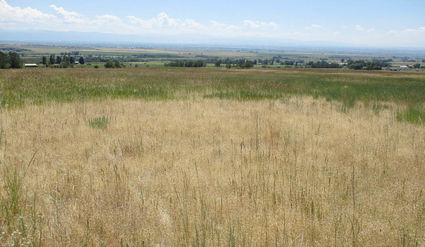Noxious Weed Ventenata Threatens Rangeland
October 3, 2019
Courtesy PR Extension Service
What if the first person in Powder River County that had a leafy spurge plant back in the 1950's knew what it was, recognized its ability to invade and sprayed/pulled/dug and destroyed it? And, then warned all the surrounding landowners about it?
We have received such a warning, regarding the grassy weed Ventenata, according to Mary Rumph, Powder River Extension Agent.
In the last two weeks, Ventenata has been discovered south of Ekalaka. The size of the infestations have yet to be determined, according to Jesse Scott, Carter County Weed Supervisor. Prior to this report, the closest known infestations were in Campbell and Sheridan Counties, Wyoming and Big Horn County in Montana, said Rumph.
Ventenata, also known as wiregrass or North African grass, is a non-native winter annual grass that is relatively new to Montana and has the potential to impact range, pasture, wild lands and annual crops. It typically grows 6-18 inches tall and has a distinguishing long, membranous ligule with reddish-black nodes along the stem. It is not to be confused with Cheatgrass (downy brome) and Japanese brome. Ventenata seedlings emerge later and are thinner, more needle-like. At maturity, Ventenata has awns like Cheatgrass, but they are bent and twisted. It reproduces by seeds. It is known to spread via roadways and contaminated forage. Contaminated seeds from Idaho and Washington are suspected as a major source for infestations in Montana. Awns can easily attach to fur, clothing, and machinery.
According to Jane Mangold, MSU Extension invasive plant specialist, Ventenata is tricky to detect and is often spotted in unsuspecting rangeland where the land does not have to be overgrazed or disturbed to be an inviting habitat. Additionally, the plant likes to grow among patches of Cheatgrass, making detection even more challenging.
Mangold stressed "Early detection coupled with rapid response is the recommended management approach to Ventenata."
According to Mangold, spraying the weed with herbicides is proving to be the best course of action. If not addressed, Ventenata can actually out-compete Cheatgrass, but unlike Cheatgrass, is unpalatable to grazing animals. Studies have shown that Ventenata has three times higher silica content than most perennial grasses, which could be the reason it is avoided. The plant reaches full maturity in late June/early July and can be identified by its open, airy like seed head and bent awns. In the fall when Ventenata starts to dry up, it is a light yellowish-brown, almost straw like color.
Ventenata was added to Montana's noxious weed list in June. It is estimated that the invasive grass infests more than 55,000 acres in Montana, but that number will continue to grow as more people become aware and learn how to identify it.
Herbicide control appears to be the best option at this time. Esplanade 200 SC (active ingredient (a.i.) indaziflam), Axiom DF (a.i. flufenacet and metribuzin), and Sinbar WDG (a.i. terbacil) are currently labeled to control Ventenata. Outrider (a.i. sulfosulfuron), Plateau/Panoramic (a.i. imazapic ammonium salt), and Laramie 25 DF (a.i. rimsulfuron) are labeled for use on cheatgrass and Japanese brome and can also be effective on Ventenata.
Landowners are encouraged to be diligent in scouting for this troublesome noxious weed, said Rumph.
"If you have questions regarding grasses in your pastures, please bring a sample to the Extension Office for identification," she added.









Reader Comments(0)